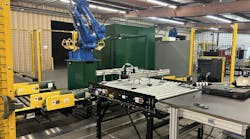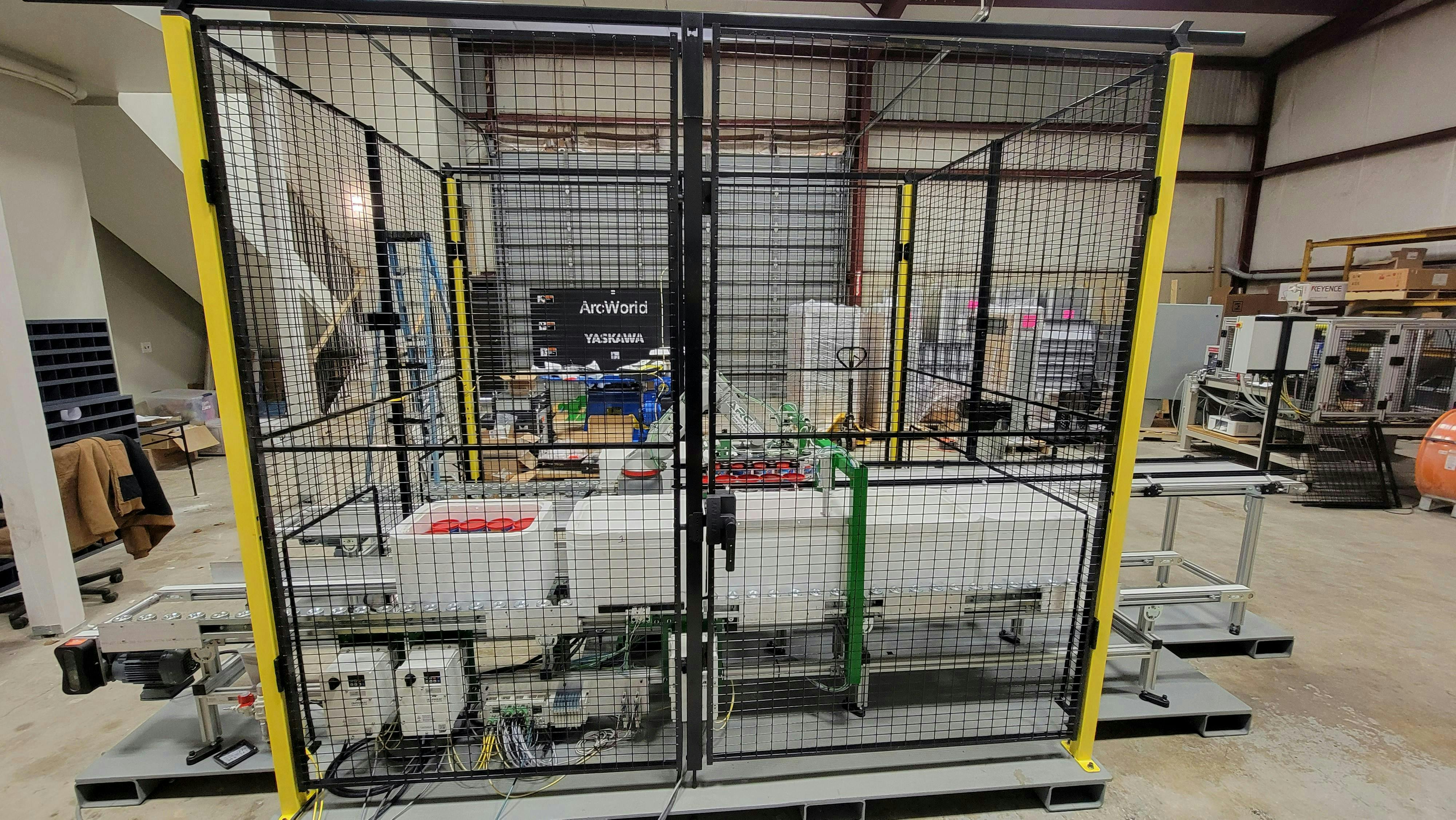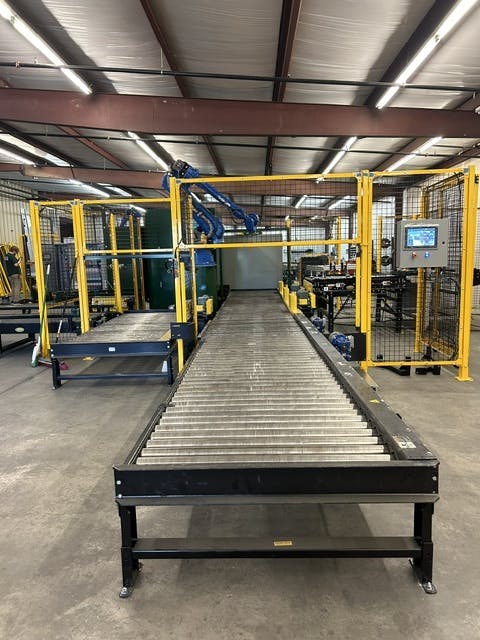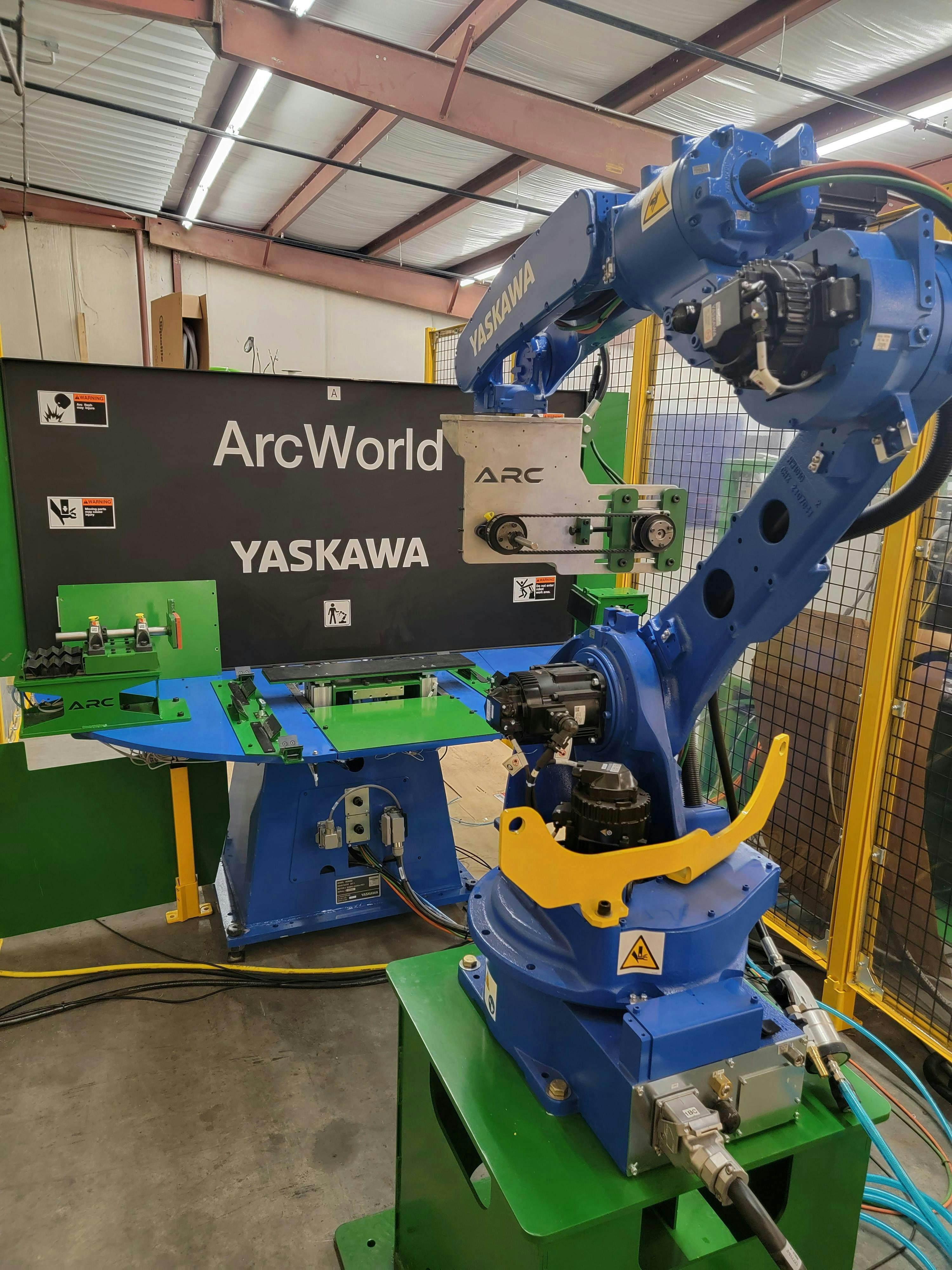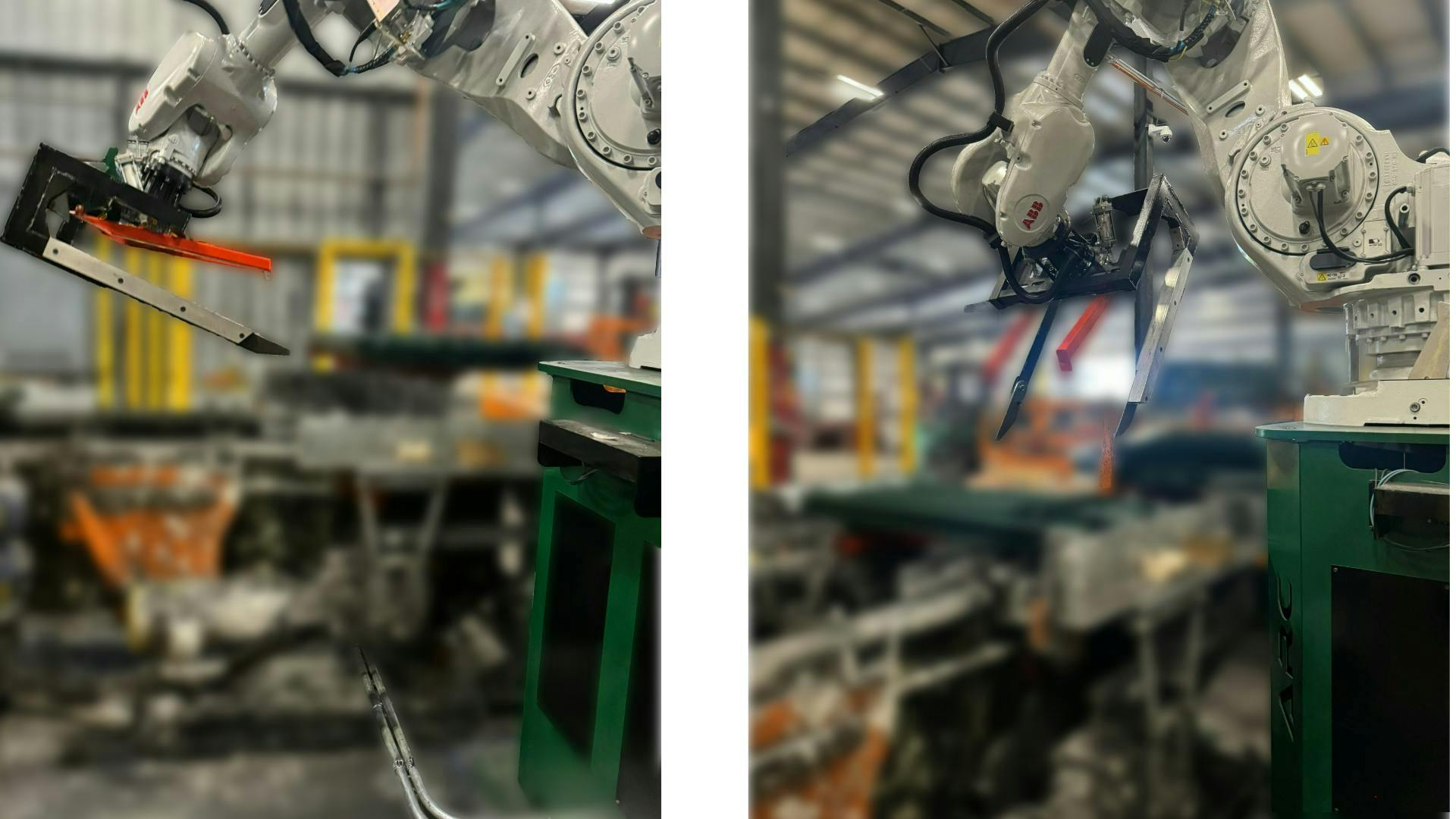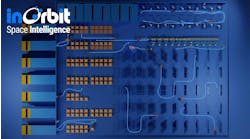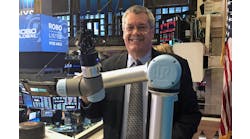Automation Robotics and Controls (ARC) is a small system integrator working on big projects, especially in robotics. ARC President Brandon Haley detailed four of its most innovative industrial robot applications, ranging from worm container packaging to appliance buffing and material handling systems for flooring and T-post manufacturers.
Get your subscription to Control Design’s daily newsletter.
1. End-of-line worm container packaging
“This was one of the many special systems that came to our doorstep. We chased this lead for quite a while,” Haley says. The worm container packaging system handles worms for the fishing industry. The bait manufacturing company, based out of Coalmont, Tennessee, makes about 80% of the fishing bait in the United States. The company owner, originally from France, had done a lot of his own controls and process design over the years and sourced a lot of different material from Europe and Asia. The original production line used cookie-cutter equipment that was fast and suited for the needs of the mold container process, but, eventually, the owner wanted a custom robotic upgrade. After purchasing four different robots at an end-of-the-year sale, the owner hired ARC to help him integrate the robots into his worm packaging system (Figure 1).
The company purchased a Yaskawa industrial robot, DX 200 series, and ARC designed a custom end-of-line tool. Each worm container had to be located and positioned to fit into the shipping container via robot. “The containers came down an assembly line, and they had to be reoriented. We had to pick 10 cups and place them into a cooler every five seconds,” Haley says. “And the problem is the orientation of the cups had to change during the five seconds, so, if we sorted them into lines, and then we picked them, we actually reoriented them as we moved them into the container.” The end-of-arm tooling used cylinders to pick and reorient the container before stacking into the cooler. The robots then stacked four layers before processing the cooler and sending it out on small Robotunits conveyors.
The original upgrade plans did not include a programmable logic controller (PLC), as the owner had done a lot of the controls in-house for the original system. The upgrade plan was to integrate into that system, but a PLC was later added to the design. “We identified that the process was not going to be able to keep up with the pace of the cooler as we designed it, and he didn’t anticipate that initially. When we had to upgrade the conveyors, we needed more I/O, so we went ahead and put in a PLC,” Haley says. The controls used an Omron PLC and components from Weidmüller, including power supplies, terminals, Ethernet switches and breakers.
2. Palletizing and de-palletizing flooring materials
A flooring manufacturer, one of ARC’s biggest customers, has worked with the system integrator on almost every part of the manufacturing process, everything from fine powder materials and laminating the material into flooring to cutting the flooring, processing the flooring, moving the flooring to a finishing building, de-stacking the flooring, recutting the flooring, CNC cutting the flooring and boxing. “We’ve done every part of the process,” Haley says.
A Yaskawa robotic system had two robots for palletizing and two for de-palletizing (Figure 2). Every four seconds, a robot takes a 36-by-48-inch slab of flooring, which eventually a machine will cut into individual flooring tiles. Before that, the robot palletizes the slab. Because the flooring lamination process can cause extreme heat and fire, if the production line starts to back up, the manufacturer cannot stop the line. “If the robot goes down, then we have to drop a stop and eject to a manual shoot,” Haley said. “That was some of the gymnastics.”
With hydraulic lift tables and level sensors, the system keeps the pass line of the conveyor and the material stack at the same level, so the robot makes a simple movement.
A fully articulated robot was not needed for that process in particular, but one was introduced into this system to pick divider boards between material at multiple pick locations. “We had two stack locations, two divider board locations and then incoming product at two positions and then a manual stop that would drop if any of it was missed,” Haley says.
Each process had to be done within four seconds, and the design also had to skew and line the material up to a flat edge. Then the process did the inverse, taking the slabs back off the stacks, though not as fast-paced as the incoming production line with a process upstream pushing the robot. “Obviously, they want to be able to feed the downstream fast enough to get their material out at a similar speed, but now we don't have to worry about stopping and damaging the machine or material,” Haley says. The type of flooring coming down the line also varies quite a bit, anything from plywood to ornate finished flooring.
“When you get to the bottom of a pallet, how do you tell the difference between the pallet and the flooring?” Haley asks, as the wood-based pallets and the flooring can look similar. “What we did was we designed an end-of-arm tool that had cylinders that act as deflectors. Each time the robot would pick the flooring up, it would actually push on the flooring, and, if the flooring had enough rigidity, then we knew if it was wood pallet or a divider board,” Haley says. The system also had a double-check with sensors and a simple vision system that would look at the bottom of the pallet. “We had a lot of redundant checks, and the rigidity check was something that was pretty ingenious from our engineers,” he adds.
3. Appliance buffing system
ARC has done a lot of work for Viking and its sub-brand of grills, Lynx, with products such as pizza ovens, a grill canopy for a grill system and a patio infrared heater. The manufacturer was struggling with the manual buffing of the high-end stainless-steel appliances. “It was just a very labor-intensive, very manual process,” Haley says. Before buffing, the appliances also needed precise taping along lines and features for a clean look.
The manufacturer had already purchased two robotic buffing systems, which were supposed to be working together but were not integrated properly. ARC programmed and integrated the buffing system with two Yaskawa robots and a Fanuc robot. The two Yaskawa systems were built from scratch, and ARC modified the Fanuc robot system in place.
“We helped them fix some of that process,” Haley says. “In any solution where you’re grinding, you really have to watch the torque feedback and position to be able to accurately gauge and perfect the material.” Before ARC, the robots and cycles were working, but the quality and throughput were greatly affected by missing details and the ability to fix those problems based on that data. “When we did our system, we showed them that they could do all that with the same components,” Haley says.
The manufacturer also bought a new system from ARC, using a Yaskawa robot system to work with an operator to load and unload product (Figure 3). The system controls a turntable for buffing and polishing the different appliances, and, at an adjacent site, an operator loads and unloads material. Together, they maximize cycle time by performing both operations simultaneously.
ARC also designed the fixturing to accommodate many different types of parts. “We put servos on a positioner, where they could load any kind of part that would fit the system, and it would actually rotate the part around, while the robot was buffing to get the bottom, top and sides. When it was done, it would spin around on a rotary table so they could load the other side,” Haley says. The robots are always running, and the operator is either loading or unloading on the other side.
The taping process can also take four to five minutes, depending on the appliance. “They would take a product up, spin it around and buff the process. And then, while that was going on, operators would either be re-taping the other product on the other side or be introducing a new product, so that works really well,” Haley says. ARC also introduced the manufacturer to using a liquid compound for buffing, rather than a rouge, saving cost and reducing waste.
4. T-post handling system
“We ripped all that out,” Haley says. “We designed a system for a 500-kg robot.” The customer chose an ABB robotic system. “Initially, it sounded simple, but, again, this is a fast-paced process,” he adds. Every 10 seconds, there’s a push on the line; then the robot has about two minutes before it has to be back in place for the next load. “You had a lot of time once you got them up and out of the way. We designed a cylinder system so that, as soon as it made the last push, it would push the arms up, holding the T-posts, so the robot would be ready and come in and scoop them, and the arms would drop back down,” Haley says.
The end-of-arm tooling was fork-style in order to pick the T-posts up, spin and place them down. The system also had to accommodate T-posts from about 2.5 to 10 feet long. The production line also alternates the placement of the T-posts on the line, so the system has to pick from alternate sides on each load.
After the fact, the manufacturer did ask for some additional tool changers to the system, so it could change the way the robots stacked some of the T-posts. ARC also expects to do more work at the some of the manufacturer’s other facilities.
